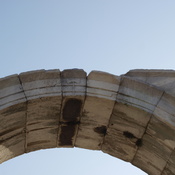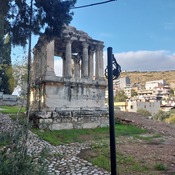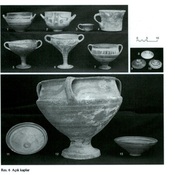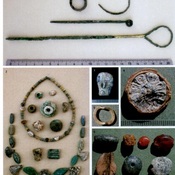Il n'y a pas une annotation en français. Présenté est une annotation en Anglais.
Ancient Mylasa was one of the most important cities in inland Caria. Early however insufficiently published finds date back to the late Bronze Age, including some fragments of Mycenaean clay vessels, probably from the 15th to 13th/12th centuries B.C. In the 5th century BC. Milasa became a part of the Attic Sea League and was the seat of the Carian rulers of the Hecatomnid dynasty in the 4th century, before king Maussolos (400-352 BC) mooved his seat to Halicarnassus ca. 360 BC. In the Hellenistic period, Mylasa belonged to different empires one after the other. During the Parthian invasion in 40 BC Mylasa was severely devastated and lost its importance. In the 4th century AD it became the seat of a Christian bishop in late antiquity.
It is possible that Mylasa can be identified with the city of Mutamutašša, which is mentioned several times in Hittite sources.
Literature:
- George E. Bean, Turkey Beyond the Maeander. An Archaeological Guide, London Ernest Jersey 1971, pp.31-44
- Max Gander: Die geographischen Beziehungen der Lukka-Länder. Texte der Hethiter, Heft 27 (2010).
- John David Hawkins: TAWAGALAWA: The Topography. In: Susanne Heinhold-Krahmer, Elisabeth Rieken (Hrsg.): Der „Tawagalawa-Brief“: Beschwerden über Piyamaradu. Eine Neuedition (= Untersuchungen zur Assyriologie und vorderasiatischen Archäologie Band 13). De Gruyter, Berlin/Boston 2019, p. 344.
- Christina G. Williamson, Chapter 3 Memory and Control: Mylasa and the Sanctuary of Zeus Labraundos, In: Urban Rituals in Sacred Landscapes in Hellenistic Asia Minor, Brii 2021 -https://brill.com/display/book/9789004461277/BP000013.xml
- The Geography of Strabo XIV.2.23, ed. H. L. Jones, The Geography of Strabo. Cambridge, Mass.: Harvard University Press; London: William Heinemann, Ltd. 1924.
Ancient Mylasa was one of the most important cities in inland Caria. Early however insufficiently published finds date back to the late Bronze Age, including some fragments of Mycenaean clay vessels, probably from the 15th to 13th/12th centuries B.C. In the 5th century BC. Milasa became a part of the Attic Sea League and was the seat of the Carian rulers of the Hecatomnid dynasty in the 4th century, before king Maussolos (400-352 BC) mooved his seat to Halicarnassus ca. 360 BC. In the Hellenistic period, Mylasa belonged to different empires one after the other. During the Parthian invasion in 40 BC Mylasa was severely devastated and lost its importance. In the 4th century AD it became the seat of a Christian bishop in late antiquity.
It is possible that Mylasa can be identified with the city of Mutamutašša, which is mentioned several times in Hittite sources.
Literature:
- George E. Bean, Turkey Beyond the Maeander. An Archaeological Guide, London Ernest Jersey 1971, pp.31-44
- Max Gander: Die geographischen Beziehungen der Lukka-Länder. Texte der Hethiter, Heft 27 (2010).
- John David Hawkins: TAWAGALAWA: The Topography. In: Susanne Heinhold-Krahmer, Elisabeth Rieken (Hrsg.): Der „Tawagalawa-Brief“: Beschwerden über Piyamaradu. Eine Neuedition (= Untersuchungen zur Assyriologie und vorderasiatischen Archäologie Band 13). De Gruyter, Berlin/Boston 2019, p. 344.
- Christina G. Williamson, Chapter 3 Memory and Control: Mylasa and the Sanctuary of Zeus Labraundos, In: Urban Rituals in Sacred Landscapes in Hellenistic Asia Minor, Brii 2021 -https://brill.com/display/book/9789004461277/BP000013.xml
- The Geography of Strabo XIV.2.23, ed. H. L. Jones, The Geography of Strabo. Cambridge, Mass.: Harvard University Press; London: William Heinemann, Ltd. 1924.







